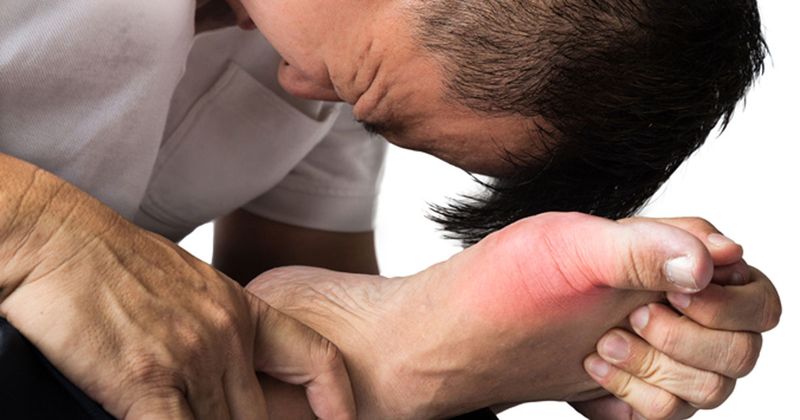'What’s new, what's missing' from 2020 ACR guidelines on gout
While the 2020 American College of Rheumatology guidelines for gout management are a step up from the 2012 iteration, gaps remain in management of the disease, according to a presenter at the 2020 Congress of Clinical Rheumatology-East.
In particular, N. Lawrence Edwards, MD, professor of medicine in the Division of Clinical Immunology at the University of Florida in Gainesville, drew attention to “what’s new, and what’s missing” in the 2020 document.

Source: Adobe Stock.
Treating to a target of uric acid levels lower than 6 mg/dl is strongly recommended for patients with “subcutaneous tophi, clinically apparent tophi and evidence of radiographic damage,” Edwards told attendees. “But we will also talk about some things that should have been better emphasized in the current gout guidelines.”
National Health and Nutrition Examination Survey (NHANES) data show that some 9.2 million Americans have gout, or about 4% of adults in the country overall, according to Edwards. Prevalence is around 5% in men and 3% in women. An additional 28 million Americans have hyperuricemia.

Despite these numbers, and despite recommendations with more strong evidence behind them in the 2020 ACR document, gout management in the U.S. remains poor. “Gout symptoms and appear and disappear,” Edwards said. “That is part of the problem of recognizing how severe this disease really is.”
With this in mind, the authors of the 2020 guidelines hope to divest the clinical community of the notion that gout develops in stages, from asymptomatic hyperuricemia through chronic tophaceous disease. “It is really a continuum starting way back in the teenage years in men and in women in the perimenopausal years,” Edwards said. “It is an accumulation of uric acid over time. That is what informed the current guidelines.”
Going Beyond the Guidelines
The most direct way this informed the guidelines can be found in the strong recommendation for a lifelong treat-to-target strategy to keep the uric acid level below the accepted threshold. “The treat-to-target model is the way we should be treating all of our patients,” Edwards said.
Another update of the previous guidelines is a strong recommendation for urate-lowering therapy for patients who have more than two flares per year. “If you have two previous flares and not within the same year, by the time you have that second flare, it is probably a good idea to start urate-lowering therapy,” Edwards added.
Regarding the choice and dose of ULT, the authors strongly recommend starting allopurinol at 100 mg/day and titrating upward to a maximum of 800 mg/day to reach the goal of > 6 mg/dl.
For patients in whom allopurinol is contraindicated, febuxostat (Uloric, Takeda) should start at 40 mg per day and be titrated up to maximum of 80 mg max. Probenecid should start at 500 mg and may be titrated up to a 3-gram maximum.
During flares, anti-inflammatory therapy should begin “pretty early on,” according to Edwards, who suggested that this treatment should be initiated within 24 hours. “If you wait longer than that, [anti-inflammatory medications] are going to be pretty ineffective” he said.
Yet another key update from 2012 is that ULT should be continued throughout flares. “This runs contrary to the old maxim of ‘don’t disrupt the equilibrium’ during a flare,” he said.
“Classic” anti-inflammatory medications such as non-steroidal anti-inflammatory drugs, colchicine, corticosteroids or some combination thereof is recommended for this purpose. “Use lower doses to avoid side effects” when using combination anti-inflammatory treatments, Edwards added.
The final change Edwards highlighted from the 2012 document calls for testing for the HLA-b5801 allele in patients of Southeast Asian and African American descent.
Beyond clinical concerns, Edwards suggested clinicians need to repeatedly drive home the message that ongoing ULT is paramount to gout management. “Forty percent of patients with gout never get touched with a day’s worth of urate-lowering therapy,” he said. “Out of the 5.5 million patients who do get treatment, about 20% will be adequately treated in perpetuity.”
As for the rest, there is no target, no persistence and no positive outcome in their disease, according to Edwards. “They do not get to avoid their symptoms,” he said.
In terms of what is missing in the 2020 guideline, a better prediction tool to assess risk for cardiovascular and chronic kidney disease associated with allopurinol is needed. “Having cardiovascular disease more than doubles the risk of hypersensitivity to allopurinol,” Edwards said.
Edwards closed his presentation with a call to arms, explaining why patients are not being treated or meeting their goals. In this regard, he was unequivocal. “What we are dealing with in the lion’s share is poor physician performance,” he said. “They are not looking at gout as a disease that needs their time and attention and not explaining the disease to their patients.”

